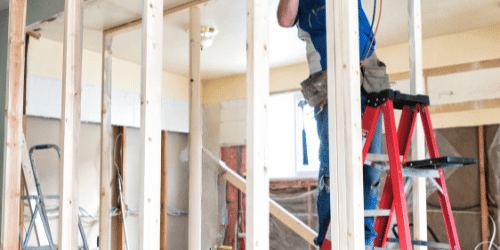Interior walls play a crucial role in defining the layout of our homes. However, there are times when removing these walls can significantly improve the functionality, flow, and overall aesthetics of a space. In this guide, we’ll explore the benefits of removing interior walls and provide step-by-step instructions for a successful project.
Removing interior walls can transform your home by creating open, airy spaces that maximize natural light and improve circulation. Whether you’re considering a kitchen remodel, expanding your living room, or creating a more open floor plan, understanding the process is essential.
Assessing Your Space
Understanding Load-Bearing Walls
Learn to identify load-bearing walls and understand when to seek professional assistance. Load-bearing walls support the structure of your home, so removing or altering them requires expert knowledge. Signs of load-bearing walls include perpendicular placement to floor joists and presence in central areas. Consulting a professional ensures safe modifications and maintains structural integrity. Don’t risk DIY for these critical changes. Always get expert help for load-bearing wall projects.
Mapping Out Your Floor Plan
Get tips for visualizing the new layout and assessing the impact on adjacent rooms. Use floor plans or design software to see the changes clearly and understand the spatial dynamics. Consider how the new layout affects traffic flow and overall functionality, ensuring easy movement and access. Pay attention to natural light and how it will spread throughout the space, enhancing the ambiance. Evaluate the impact on nearby rooms, ensuring harmony and consistency in design and style. Visualizing helps anticipate challenges, refine your design effectively, and create a cohesive living environment. This preparation ensures a smooth transition and a successful remodel.
Permits and Regulations
Learn to navigate local building codes and obtain necessary permits for your remodeling project. Start by familiarizing yourself with Prosper, TX, regulations to ensure compliance. Research specific requirements for your project type, such as electrical, plumbing, or structural changes. Prepare and submit detailed plans for approval to the local building department. Schedule necessary inspections at various stages of the construction process. Consulting with professionals can simplify this complex and time-consuming process. Ensuring all permits are obtained and inspections passed keeps your project legal, safe, and up to code. This diligence prevents future issues and ensures a smooth remodeling experience.
Preparing for the Project
Safety Measures
Learn about essential protective gear, tools, and precautions for a safe remodeling project. Always wear safety glasses, gloves, and a dust mask to protect yourself from debris and harmful substances. Use sturdy ladders and scaffolding for elevated work. Keep a first-aid kit nearby for emergencies. Ensure all power tools are in good working condition and handle them with care. Follow safety guidelines for each tool to prevent accidents. Take precautions like turning off electricity when working on wiring. Proper safety measures protect you and ensure a smooth, accident-free project.
Removing Drywall and Finishes
Follow step-by-step instructions for safely removing drywall, baseboards, and other finishes in your remodeling project. Start by turning off electricity to the area and removing any furniture or belongings. Score the drywall with a utility knife along studs, then carefully pry it away from the studs with a crowbar. Use a pry bar or hammer to gently remove baseboards, being mindful of nails and screws. Dispose of materials responsibly. Wear protective gear like gloves and goggles throughout the process. Take your time to avoid damaging surrounding areas. Following these steps ensures a smooth and safe removal process, setting the stage for your remodeling project.
Electrical and Plumbing Considerations
Learn how to reroute electrical wiring and plumbing lines safely and effectively for your remodeling project. Start by turning off the main power and water supply to the area. Plan the new routes carefully, considering accessibility and code requirements. Use appropriate tools, such as wire cutters and pipe wrenches, to disconnect existing lines. Install new wiring and pipes following local building codes and safety standards. Test connections thoroughly before restoring power and water. Seek professional assistance if you’re unsure about any aspect of the process. Rerouting electrical wiring and plumbing lines requires precision and caution to ensure proper functioning and safety in your renovated space.
Demolition and Structural Changes
Demolishing the Wall
Learn techniques for breaking down walls without damaging surrounding areas during your remodeling project. Start by removing any furniture or objects nearby and covering floors and adjacent surfaces with protective materials like drop cloths or cardboard. Use a hammer and chisel to create a starting point, then work systematically, tapping along the edges to loosen the wall gradually. Avoid using excessive force to prevent collateral damage. Consider renting a demolition hammer or reciprocating saw for larger projects, as these tools offer more precision and control. Take breaks to assess progress and adjust your approach as needed.
Reinforcing Structural Integrity
When compensating for a removed wall during your remodeling project, consider installing support beams or headers to maintain structural integrity. Start by consulting with a structural engineer or contractor to determine the appropriate size and type of beam needed for your specific project. Ensure that the beam is properly sized and supported to bear the load previously carried by the wall. Use temporary supports to hold the load while installing the beam, and secure it in place with appropriate fasteners. Follow local building codes and regulations throughout the installation process.
Finishing Touches
After removing a wall or completing other demolition work, it’s essential to patch holes, sand surfaces, and prepare for the next steps in your remodeling project. Begin by filling any holes or gaps in the walls with spackle or joint compound, using a putty knife to smooth the surface. Once dry, sand the patched areas and surrounding surfaces until smooth and level. Use a vacuum or tack cloth to remove any dust or debris before proceeding. Prime the patched areas to ensure proper adhesion of paint or other finishes. Take your time with these steps to achieve a seamless transition between old and new surfaces. Proper preparation sets the stage for a successful remodeling project.
Designing the New Space
Choosing Flooring and Finishes
When remodeling, coordinating flooring materials and finishes is crucial for achieving a seamless transition between different spaces. Start by selecting flooring materials that complement each other in color, texture, and style. For example, consider using hardwood in common areas and carpet in bedrooms for a cohesive look. Alternatively, opt for tile in wet areas like bathrooms and kitchens, transitioning to hardwood or laminate in adjoining rooms. Pay attention to the finish of the flooring as well, ensuring consistency throughout the home. If transitioning between different types of flooring, use transition strips or thresholds to create a smooth and visually pleasing connection.
Lighting Solutions
Maximizing natural light and incorporating artificial lighting are essential strategies for enhancing the ambiance and functionality of any space during a remodeling project. Start by maximizing natural light through strategic placement of windows, skylights, and glass doors to allow ample sunlight to flood into the room. Consider using light-colored paint or reflective surfaces to bounce natural light further into the space. Additionally, incorporate artificial lighting sources such as overhead fixtures, recessed lights, and task lighting to provide adequate illumination, especially during darker hours. Use dimmer switches to adjust lighting levels according to different activities and times of day. Finally, consider installing smart lighting systems that can be controlled remotely to create the perfect ambiance and conserve energy.
Creating Functional Zones
Defining separate areas within an open floor plan can be achieved through several design techniques. Start by using area rugs or furniture placement to visually divide the space into distinct zones, such as a living area, dining area, and workspace. Additionally, consider using architectural elements like half-walls, columns, or built-in shelving to create physical boundaries without fully closing off the space. Utilize different flooring materials or changes in ceiling height to delineate between areas. Incorporate lighting fixtures such as pendant lights or floor lamps to highlight specific zones.
Common Questions Answered
Q1 Can I Remove a Load-Bearing Wall Myself?
A1 Explaining when to hire a professional structural engineer.
Q2 What About HVAC Ducts and Vents?
A2 Addressing ventilation and heating considerations.
Q3 Will Removing a Wall Affect Resale Value?
A3 Discussing the impact on property value.
Impact of Natural Light
Natural light plays a significant role in creating a welcoming and spacious atmosphere. We’ll explore how removing interior walls can enhance the distribution of sunlight throughout your home.
Seeking Expert Advice
While this guide provides valuable insights, always consult with a professional remodeling contractor or architect before starting your project. Their expertise ensures safety, compliance, and optimal results.
Conclusion Wall Removal
Transformative potential of removing interior walls to optimize space and elevate your home’s functionality. Whether envisioning an open-concept kitchen, expanding a living area, or fostering seamless room transitions, understanding the process proves crucial. Key considerations encompass visualizing your ideal layout before commencing demolition, consulting professionals for guidance on load-bearing walls, and prioritizing safety throughout the project. Reinforcing structural integrity through support beam installation and meticulous finishing work ensures a polished outcome.
Crafting the new space involves selecting cohesive flooring, finishes, and lighting solutions, while delineating functional zones within the open layout. Addressing common queries regarding load-bearing walls, HVAC ducts, and resale value impact adds clarity to the process. Enhanced natural light distribution emerges as a notable benefit, fostering a brighter and more inviting ambiance. Collaboration with remodeling experts or architects remains pivotal for project success, complementing the insights offered in this guide.
Visit us at Pristine Luxury Remodeling
For more information and personalized guidance visit us at Pristine Luxury Remodeling, We specialize in providing exceptional remodeling services that elevate your space into a masterpiece of luxury.







